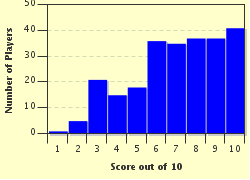Quiz Answer Key and Fun Facts
1. According to ancient myth, the origins of the Roman triumph, an idea inspired by similar events celebrated by the Etruscans, began in the eighth century B.C. with the celebration of their victory over the Caeninenses. Which founding father of the city of Rome was being honoured in this triumph?
2. Triumphs were not just granted to every Tomius, Dickius or Harrius. During the time of the Roman Republic, (509-27 B.C.), a list of requirements was created which a victor had to satisfy before being considered worthy of triumphal honours. Which of these was NOT a contributing factor when making this decision?
3. Traditionally the triumphal procession consisted of many participants broken into three separate groups. Taking his place within the second of these groups, what was the usual mode of transport the one who was being honoured used as he made his way through the streets of Rome?
4. Many have tried to piece together a traditional route followed by the triumphal march from surviving eyewitness accounts. While this has provided a general idea, albeit with various deviations, one thing agreed upon is the final destination of the triumph. If I told you that animal sacrifices were made to the chief God of the Roman pantheon at this site, where do you suppose the final stop of the triumph was?
5. If one desired to view a list of Roman triumphs from their beginning to the late first century B.C., one could do worse than seek out certain artefacts discovered in the sixteenth century A.D. These marble tablets are inscribed with extensive details of more than 200 triumphs celebrated in early Rome. By what name are they known?
6. The misfortunes of one man led to the greater fortunes of another when the Romans defeated the Carthaginians in the Battle of Mylae during the first Punic War. Caius Duilius was awarded a triumph in 260 B.C. for this victory, the first triumph of its kind for what distinguishing feature?
7. In 61 B.C., Pompey the Great was rewarded for his victory over, and capture of King Mithradates VI with his third triumph. This was the first occasion on which anybody had celebrated three triumphs for victories on three separate continents. Which continent was it that Pompey conquered on last to achieve this feat?
8. In 46 B.C., Julius Caesar celebrated a quadruple triumph for victories in four separate wars. Amongst the prize posessions displayed at one of these triumphs was which defeated leader who united the tribes of his homeland against Caesar in the Gallic Wars?
9. Many monuments were erected in Rome as a lasting reminder of those who had celebrated triumphs there. One such structure was built by Emperor Domitian and dedicated to his deceased elder brother and predecessor as Emperor. What was the name given to this monument?
10. There is some debate surrounding the subject of the last Roman triumph. One candidate is that which was celebrated by General Flavius Belisarius in 534 A.D. Granted to him under the rule of Emperor Justinian, who was firmly entrenched in the eastern capital of the Empire, in which city did this triumph take place?
Source: Author
Aussiedrongo
This quiz was reviewed by FunTrivia editor
bloomsby before going online.
Any errors found in FunTrivia content are routinely corrected through our feedback system.

